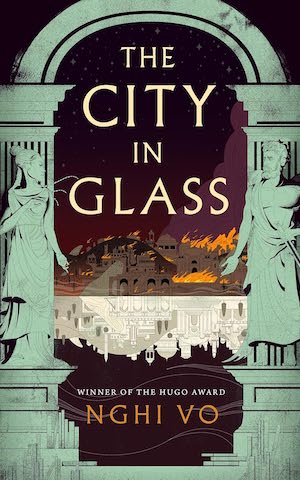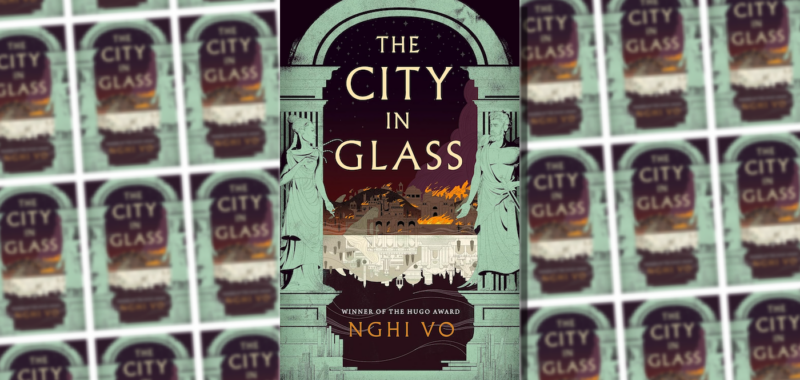If you are already a fan of Nghi Vo, I’m not about to tell you anything new in this review of her latest book. The City in Glass is incredible, which is par for the course for her. If you haven’t had the pleasure yet of experiencing her writing then consider this the textual equivalent of me throwing this book at you. Either way, as soon as you’re done reading this, go to your nearest library or bookstore and pick up a copy.
The city of Azril belonged to the demon Vitrine, and the demon Vitrine belonged to the city of Azril. Even if Azril didn’t know it. Centuries ago, Vitrine washed up on the shores of the city that would become Azril along with other refugees who sought safety within her borders. With careful pruning, boundless energy, and a penchant for capricious violence, Vitrine shaped and grew her new home into a thriving metropolis. Azril was a mecca for trade and artistry, a place where scoundrels, merchants, mercenaries, families, and immigrants could live in relative harmony. Those to whom Vitrine took a liking would find themselves blessed or cursed, often both at the same time. She whispered lies in their ears and opened their eyes to great truths. She patronized those who needed her support and tested those who needed toughening up. And their stories, with all their passions and tragedies, were recorded in the little book she kept in a glass cabinet inside her chest. Until the day the angels came and destroyed everything.
Like titans from the sky, the angels spread across Azril and razed her to the ground with holy fire. Nothing lived, nothing survived, nothing was left standing. A whole city full of dreams and stories and lives only just begun gone in a single night. Unable to stop them, Vitrine used what little power she had and condemned one of the destroyers with a poisonous curse. It nearly cost her her life, but if she were to die, at least it would be in defense of the city she loved.
Buy the Book


The City in Glass
The City in Glass begins with an ending and ends with a beginning. We witness Azril’s destruction and Vitrine’s grief, then both of their gradual recoveries. As Vitrine mourns her loss, the readers get glimpses into the lives of some of the names recorded in her book. We learn how Azril was nothing but a pirate-ravaged port town before our demon showed up and the victories and failures she and her city endured over the years. We see their growing pains and their over-exertions. We learn why she loved her city so much and why it broke her so badly when it was taken from her. She was no benevolent god or kindly fairy godmother but she did want the best for her city, even if sometimes that meant blood and pain.
We also see her relationship with the angel she cursed evolve alongside what is born from Azril’s ashes. What surprised me by the end was how The City in Glass was a love story in all definitions and expressions of “love.” Familial, romantic, sexual, platonic, queerplatonic, the love between a parent and child, the love between people bonded by terrible trauma, the love experienced by someone eating a favorite food prepared by a beloved companion, the love between a pet and their person, the love that blooms in a found family, and on and on. The relationship between the demon and her angel is tempestuous and mercurial. Neither are ever quite sure where they stand with each other, but eventually they realize that doesn’t matter.
Vo has that rare talent of not only coming up with thoroughly unique stories but structuring them with prose so beautiful it almost reads like poetry or a song:
Vitrine hit the ground like a star, sending up a wave of dust and grime, sinking into what had been Murrine Square before the angels came. It was where the glassblowers had set up their outdoor stands, puffing out globes of red and green and yellow for perfume bottles, witch’s balls, and amphitres of poison. Sunk a good few feet below the surface of the street, Vitrine could smell decades of copper for blue and garnet-gold for ruby, almost as it was before.
In many ways, it reminds me of other speculative stories: This Is How You Lose the Time War by Amal El-Mohtar and Max Gladstone, Tread of Angels by Rebecca Roanhorse, Witch King by Martha Wells, The Dead Cat Tail Assassins by P. Djèlí Clark. Yet it is also wholly itself.
Despite its short length, this novel is packed to the brim with details. Vo offers peeks at other lands and cultures and how they influence the new and old Azril. Human characters come and go, sometimes making only brief appearances and sometimes living their whole lives in a few pages, but no matter what, they all feel fully realized and realistically complicated. I won’t spoil the story of Alex, the trans mercenary, but his is my favorite of the bunch. I want a whole novel from Nghi Vo about his adventures, but if I can’t have that, at least I have The City in Glass.
The City in Glass is available from Tordotcom Publishing.

